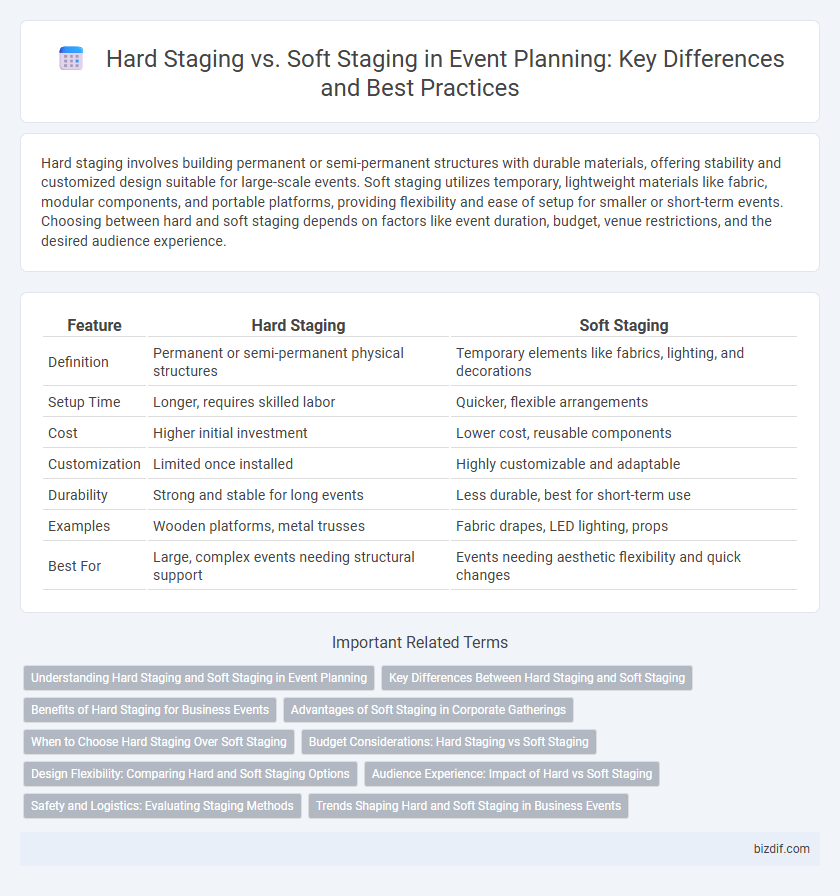Hard staging involves building permanent or semi-permanent structures with durable materials, offering stability and customized design suitable for large-scale events. Soft staging utilizes temporary, lightweight materials like fabric, modular components, and portable platforms, providing flexibility and ease of setup for smaller or short-term events. Choosing between hard and soft staging depends on factors like event duration, budget, venue restrictions, and the desired audience experience.
Table of Comparison
| Feature | Hard Staging | Soft Staging |
|---|---|---|
| Definition | Permanent or semi-permanent physical structures | Temporary elements like fabrics, lighting, and decorations |
| Setup Time | Longer, requires skilled labor | Quicker, flexible arrangements |
| Cost | Higher initial investment | Lower cost, reusable components |
| Customization | Limited once installed | Highly customizable and adaptable |
| Durability | Strong and stable for long events | Less durable, best for short-term use |
| Examples | Wooden platforms, metal trusses | Fabric drapes, LED lighting, props |
| Best For | Large, complex events needing structural support | Events needing aesthetic flexibility and quick changes |
Understanding Hard Staging and Soft Staging in Event Planning
Hard staging in event planning involves the use of solid, permanent structures like platforms and scaffolding to create a stable and durable setup, ideal for large-scale concerts or corporate events. Soft staging incorporates temporary, flexible materials such as fabric, inflatable components, and modular elements that allow for quick assembly and customization, often used in trade shows and smaller gatherings. Choosing between hard and soft staging depends on factors such as event duration, budget, venue constraints, and the desired aesthetic impact.
Key Differences Between Hard Staging and Soft Staging
Hard staging involves the use of permanent or semi-permanent structures such as metal trusses, rigid platforms, and solid flooring that provide stability and durability for events with heavy equipment or large crowds. Soft staging uses lightweight, portable materials like fabric backdrops, inflatable stages, and modular platforms that offer flexibility and ease of setup, ideal for smaller or temporary events. Key differences between hard and soft staging include durability, setup time, load capacity, and adaptability to various event environments.
Benefits of Hard Staging for Business Events
Hard staging offers unparalleled structural stability and durability that ensures safety during large-scale business events, accommodating heavy equipment and large audiences. It facilitates seamless integration of advanced audiovisual technologies and lighting systems, enhancing the overall attendee experience with professional-grade production quality. The reusable nature of hard staging results in cost savings over multiple events, while its modular design allows for customizable configurations tailored to specific event layouts and branding needs.
Advantages of Soft Staging in Corporate Gatherings
Soft staging in corporate gatherings enhances flexibility by allowing easy customization of decor and layout, creating a more inviting atmosphere that promotes engagement and networking. It reduces setup and teardown time compared to hard staging, resulting in lower labor costs and less disruption to event flow. The lightweight, portable materials used in soft staging also contribute to sustainability by minimizing transportation and waste.
When to Choose Hard Staging Over Soft Staging
Hard staging is ideal for events requiring durable, load-bearing platforms such as concerts, conferences, or large-scale performances where heavy equipment and complex setups are involved. This type of staging ensures enhanced stability and safety, making it suitable for outdoor events or venues with uneven terrain. Choose hard staging when long-duration use and structural integrity are critical to the event's success.
Budget Considerations: Hard Staging vs Soft Staging
Hard staging typically involves a higher budget due to durable materials, extensive construction, and professional installation, making it ideal for large-scale or recurring events. Soft staging offers cost-effective solutions with fabric draping, lightweight props, and temporary setups that reduce expenses in labor and materials. Choosing between hard and soft staging hinges on event frequency, longevity, and overall budget constraints.
Design Flexibility: Comparing Hard and Soft Staging Options
Hard staging offers superior design flexibility through modular, durable components that can be reconfigured for diverse event layouts and themes. Soft staging provides a more adaptable surface with lightweight materials, allowing quick customization but often lacking structural complexity. Choosing between hard and soft staging depends on event scale, aesthetic requirements, and desired level of design versatility.
Audience Experience: Impact of Hard vs Soft Staging
Hard staging creates a structured and professional environment with elevated platforms and fixed setups that enhance visibility and reinforce the event's formality. Soft staging employs flexible, comfortable arrangements using cushions, rugs, and modular furniture, fostering a relaxed and intimate atmosphere that encourages audience interaction. The choice between hard and soft staging directly influences audience engagement, accessibility, and overall sensory experience during live events.
Safety and Logistics: Evaluating Staging Methods
Hard staging offers enhanced structural stability with reinforced materials, providing superior safety for large-scale events and heavy equipment setups. Soft staging, while more flexible and easier to install, may present challenges in load-bearing capacity and weather resistance, impacting overall event logistics. Careful evaluation of venue requirements, audience size, and equipment weight is essential to determine the most secure and efficient staging method.
Trends Shaping Hard and Soft Staging in Business Events
Hard staging in business events emphasizes durable materials, modular structures, and advanced lighting technology to create immersive, customizable environments that enhance attendee engagement. Soft staging trends focus on comfort, aesthetics, and sustainability, incorporating plush seating, eco-friendly fabrics, and flexible layouts that foster collaboration and networking. The integration of hybrid elements combining hard and soft staging supports evolving event formats, balancing functionality with ambiance to optimize participant experience.
Hard staging vs soft staging Infographic

 bizdif.com
bizdif.com